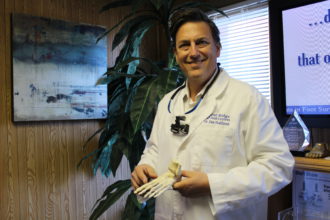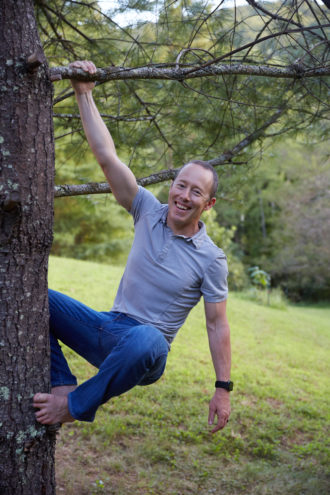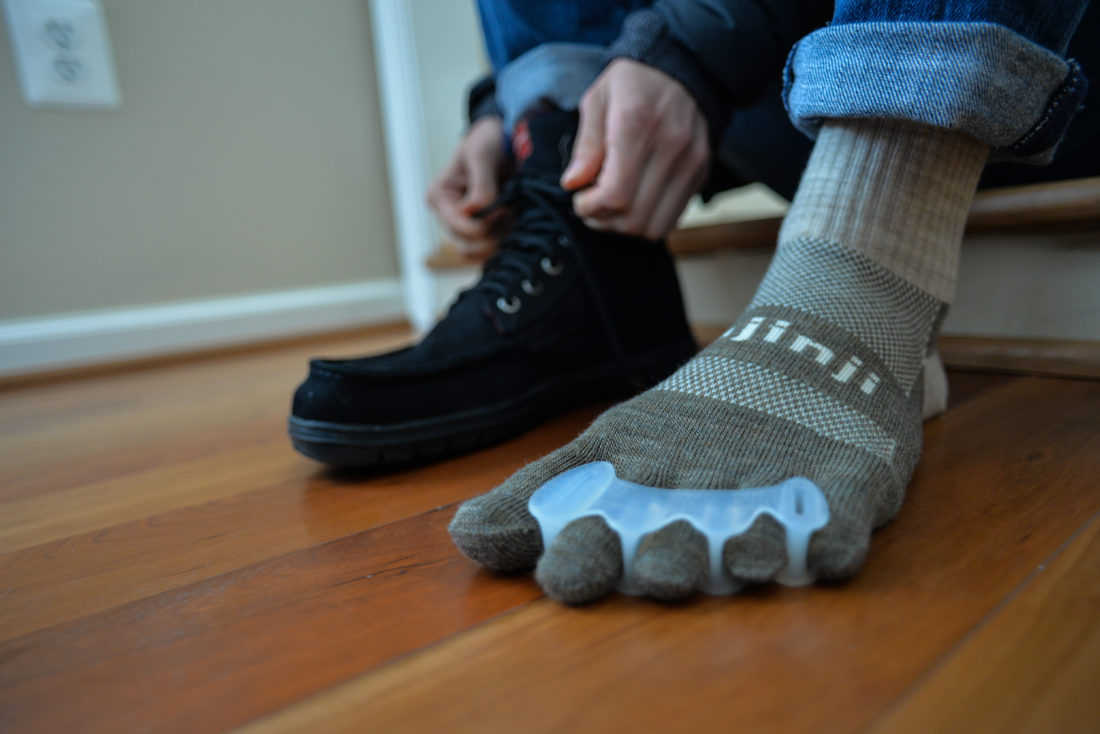When Dr. Robyn Hughes decided to focus her naturopathic practice on helping patients with foot problems, friends often suggested that her specialization sounded “pretty niche.” What Hughes learned over her years of training and practice, however, is that foot pain — and especially heel pain — is an extremely common problem.
Millions of people, Hughes says, experience foot issues that limit their activities, but many do their best to simply ignore the discomfort. “I guess people don’t talk about it. Either they think it’s not interesting, or it’s just normal to have foot pain,” she says.
Other area practitioners say there’s plenty of business to go around when it comes to treating common foot ailments. And they agree on the No. 1 type of problem that motivates patients to seek relief: pain at the base of the heel that’s most intense upon getting out of bed in the morning or standing and walking after a period of inactivity.
But there the agreement ends. Conventional and alternative practitioners alike debate whether the common disorder should be known as plantar fasciitis — indicating an inflammation of the tissues — or plantar fasciosis — a name that points to insufficient blood supply and resulting tissue deterioration. Beyond the choice of the most appropriate term, opinions about the cause and treatment of the condition differ significantly as well.
Back on their feet
Michigan native Dr. Daniel Waldman has been practicing podiatry at Blue Ridge Foot Centers on Biltmore Avenue just south of downtown Asheville since 1993. These days, as his own two children are leaving the nest, he’s treating the teenage children of some of his early patients. Over the years, Waldman says, he’s transitioned his clinic to focus on “taking care of the more acute problems,” generally referring more complicated issues such as chronic diabetic ulcerations of the feet or complex orthopedic problems to larger group practices.

Heel pain, Waldman says, tops the list of the most common conditions he sees, followed by “fractures, ingrown toenails, warts and quite a bit of dermatology.”
Especially this time of year, as people follow through on New Year’s resolutions to get into shape, “They have great intentions to get out there and run or start working out, but then their foot problem happens. That can be a setback, so I look at myself as part of the team that can help keep the patient active,” he explains.
Following an initial conversation to suss out clues to factors such as specific activities or shoes that might contribute to the patient’s problem, Waldman works with longtime medical assistant Amanda Ward to conduct a physical examination and diagnostic procedures that can include X-rays and ultrasound exams. Those measures help him determine whether inflammation or some other issue is the source of the pain.
Once Waldman has ruled out conditions that could mimic plantar fasciitis, he works with the patient to determine the best treatment options. “Not everybody needs a steroid shot,” he says, adding that fear of a shot keeps many patients from seeking help. Other approaches include radio-wave therapy to stimulate healing, cold laser therapy to reduce pain and custom orthotics or arch supports to bring a person’s gait into better balance.
“One of the things I’m proud of is I use a lab here in town that makes our devices, so I’m trying to keep the business locally,” Waldman says. And if adjustments are needed, they often can be made the same day. Waldman also sees local shoe retailers with professional staff as an adjunct to his practice. An experienced shoe salesperson, he says, can “recommend a good type of shoe for that patient’s foot structure while they’re right there in the store.”
Breaking with convention
During her naturopathic education in Portland, Ore., Hughes had a rotation with Dr. Ray McClanahan, who initially trained and practiced as a conventional podiatrist.
Hughes’ mentor had had an epiphany while spending time in West Africa. An elite competitive runner, McClanahan noticed that the local runners weren’t suffering the kinds of foot injuries that plagued him. That realization ran counter to his medical training, which insisted that feet need motion control and support to avoid damage. If the African runners, shod in sandals, were running in top form without injury, he reasoned, restoring natural foot function might make more sense than interventions that rely on medical technology.
Hughes could relate to McClanahan’s story because she too had battled injury as a young runner and rugby player. “I was constantly getting injured. I had shin splints, knee pain and a lot of sprained ankles. Around 19, I went to an orthopedist. They suggested orthotics, specialized shoes, icing and taping,” she says.
Following those instructions only led to more injury. “The doctor said I was breaking down early,” Hughes recalls. A few years later, inspired by what she was learning at McClanahan’s clinic, she began using Correct Toes, a toe-spacer designed to be worn either barefoot or inside roomy, flat footwear; Hughes says initially she wore mostly Crocs sandals.
Correct Toes are made from flexible silicone and gently spread and align the toes. According to the company’s website, “With progressive and consistent use while active and weight bearing, toes align and feet strengthen, restoring your foot’s original position and function.”
That was over 10 years ago. Since then, “I’ve had no knee pain, no sprains. Running is no problem,” she says.
On a different path
When Hughes and her husband, Dr. Marty Hughes, a chiropractic physician, moved to Asheville several years ago, she established a practice near what was then Greenlife Grocery focused on helping people with foot problems
Soon, she says, “I realized: My patient visits are an hour-and-a-half long. I’m talking a lot, just trying to educate them about natural foot health. It’s taking a lot of time, and it’s a lot for them to remember.” Wouldn’t it make sense, she thought, to create a website where patients could access that information?
And so Marty developed naturalfootgear.com to provide free education and resources for natural foot health. Not long after, he decided to list a few of the products Robyn had been selling in her clinic: Correct Toes spacers, metatarsal pads and select brands of movement-friendly shoes. The web store grew quickly, so quickly that Robyn left her practice to focus with Marty on the burgeoning business.
“I left with the idea that I’d go back, but the site just kept growing,” Robyn recalls. “We decided that it’s working — people are getting the information they need. They don’t have to spend all this money for a visit with me. It’s reaching way more people than I could ever reach on a one-to-one basis seeing patients. It’s less expensive for patients and less expensive for me with the overhead from the practice. And our reach is so much wider. Now it’s been our focus for the last seven years.”
The site now has over 20,000 newsletter subscribers. From warehouses in Asheville and Michigan, the company ships products all over the United States and internationally. Marty says the company plans to phase out selling minimal shoes, focusing instead on providing unbiased shoe reviews along with links to sites where the shoes can be purchased, while continuing to sell accessories and other supplies. In the coming months, the pair also plans to offer informational seminars, including some in WNC.
At the minimum
Robyn and Marty both stress that conventional treatment has its place. Still, options such as steroid injections (which can be hard on the liver), expensive orthotics and disruptive orthopedic surgery shouldn’t be viewed as the first line of approach, they say.
“The biggest issue is [those treatments] don’t address the underlying cause of the problem. Often people using these approaches get out of pain, but they don’t stay out of pain,” Robyn notes.
The Hugheses’ recommendations for stopping heel pain are largely the same as their suggestions for many problems of the lower extremities, including bunions, hammertoes, weak arches, Morton’s neuroma and sesamoiditis, among others. First, Marty says, look for healthy footwear that allows the foot to spread naturally and travel through a full range of motion. When the foot can move without constriction or external support, it regains muscle tone and limberness, leading to better function and reduced pain. He recommends lightweight, flexible shoes with a completely flat sole that are widest at the tips of the toes.
“If your work doesn’t allow this type of footwear, try to spend as much time in minimal footwear outside of work as possible,” Marty says. He notes that some types of specialized athletic shoes — such as cleats, climbing shoes, cycling shoes and ski boots — are also very rigid and ideally should only be worn for limited periods.
Finding ways to actively spread your toes, performing simple foot exercises and going barefoot some of the time are other good ways to begin rebuilding strength in feet that have been cooped up in stiff footwear for decades, suggests Robyn.
It’s important to take the transition slowly. “I’ve had patients get really excited to switch, and they run out and buy Vibram FiveFingers and go for a 6-mile run. That’s not a good idea,” Robyn says. “You need to wear the footwear for short periods doing lower-impact activities.”
“It took a long time for your foot deformities to occur,” she adds. “Most of them can be undone, but not overnight.”
Joy in motion
Asheville massage therapist and movement coach Mo Goldstein agrees with Robyn about the need to make a gradual transition to any new way of moving the body. Enthusiastic converts to the natural approach can fall victim to what he calls “the happy little kid first day of summer vacation wild animal joy.”

Doing too much too quickly often leads to injury. “I think that’s what almost killed the minimal shoe movement,” Goldstein says, recalling one client who suffered a stress fracture in his foot from exuberant overuse early in his treatment.
In an April 2013 article, Outside tracked the rise of the minimal athletic shoe trend, including the 2004 introduction of the Nike Free minimal running shoe and the 2009 publication of Chris McDougal’s Born to Run, a best-seller that introduced the idea of minimal footwear to the masses.
A 2011 article in Runner’s World wryly notes, “Bare feet were not invented in 2009 and have been the footwear of choice for many top and other runners long before the current fashion.” That fashion didn’t last, its demise perhaps hastened by a class-action lawsuit filed against Vibram FiveFingers in 2012 that claimed the brand had made unsubstantiated health claims. The suit was settled in 2014, with Vibram purchasers receiving compensation of between $8 and $20 per pair, according to Consumerist, a publication of Consumer Reports, and the website Top Class Actions.
Vibram did not admit to making inaccurate claims as part of the deal, and the company continues to produce its distinctive shoes, which have pockets for each toe.
Though the number of minimal shoes offered by major manufacturers has dropped significantly since the height of the minimal footwear craze, specialty producers like Lems Shoes and Vivobarefoot, among others, continue to command a small share of the footwear market.
Wrong foot?
Waldman, on the other hand — ahem, foot — says he’s not a fan of the minimalist footwear movement, especially in the urban environment.
“Walking on hard concrete surfaces, shoes are there to help cushion the foot against that impact and also to protect against stepping on sharp objects,” he says, going on to list with relish some of the things he’s removed from Ashevilleans’ feet, from toothpicks and glass to sea urchin and stingray spines and embedded hair fibers.
“There may be some people that feel like they’re more comfortable walking around the house barefoot or in socks or slippers,” Waldman allows. “That’s a personal choice.”
Waldman attributes the prevalence of plantar fasciitis — which he says most people will experience at some point in their lives — to variations in anatomy. Flat feet, he says, “tend to stretch the ligament on the bottom of the foot, and over time that can weaken the attachment at the heel and create irritation.” Alternately, patients with very high arches can bear a lot of weight directly on the heel. The problem seems to afflict people of all ages and in many different walks of life.
Physical therapy, especially stretching exercises, are helpful adjuncts to treatment, Waldman says. “I have had a number of patients [receive] acupuncture for chronic pain,” he continues. “Depending on the patient, it can be beneficial.” Massage, especially when performed by a well-trained practitioner with experience addressing foot issues, can increase circulation and “feels great,” he says.
Self-help
For folks suffering from plantar fasciosis (the term he favors), Goldstein says he usually offers a combination of movement coaching and “horribly painful bodywork,” which consists of a scraping and manipulation technique that frees “unpleasant lamination in the tissues of the feet.” The bodywork technique alone can relieve clients’ symptoms, Goldstein says, but the pain will eventually return unless they change their movement patterns.
Foot movement exercises and self-massage techniques help keep the tissues of the foot as pliable and healthy as possible, Goldstein says, whether or not clients decide to wear minimal shoes or incorporate other lifestyle suggestions.
Goldstein stresses that the strategies he teaches don’t cure everything. “I’ve worked with people who have situations I haven’t been able to help them find a solution to,” he says.
Still, Goldstein continues, “The solutions I’m offering are pretty low-cost and pretty low-risk. It’s very noninvasive; it’s very cost-effective. And I think most people respond well to the idea that they can establish a little bit of autonomy over their own health.”




Before you comment
The comments section is here to provide a platform for civil dialogue on the issues we face together as a local community. Xpress is committed to offering this platform for all voices, but when the tone of the discussion gets nasty or strays off topic, we believe many people choose not to participate. Xpress editors are determined to moderate comments to ensure a constructive interchange is maintained. All comments judged not to be in keeping with the spirit of civil discourse will be removed and repeat violators will be banned. See here for our terms of service. Thank you for being part of this effort to promote respectful discussion.